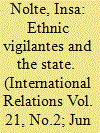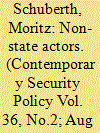| Srl | Item |
| 1 |
ID:
077391


|
|
|
|
|
| Publication |
2007.
|
| Summary/Abstract |
Based on the example of the Oodua People's Congress (OPC) in Nigeria, this article argues that vigilante activities are embedded in a range of social relations and historical trajectories. While vigilantism transforms relationships of power within the state, it does not necessarily undermine all aspects of state authority. After the annulled presidential election of a Yoruba speaker in 1993, the OPC was founded with the explicit political aim of safeguarding Yoruba ethno-nationalist interests vis-à-vis the state. By fighting crime, and state institutions perceived to be implicated in the perpetration of crime, including the police and military, the OPC's vigilantes have undermined and challenged the state's security institutions. Representing the state as both weak and strong, the OPC has undermined the state's control of security but legitimised and strengthened the state as a mechanism of political decision-making and social reform.
|
|
|
|
|
|
|
|
|
|
|
|
|
|
|
|
| 2 |
ID:
140340


|
|
|
|
|
| Summary/Abstract |
The proliferation of irregular armed actors which defy simplistic definition has caught public and academic attention alike, not least in the pages of this journal. To move the debate on non-state armed groups (NSAGs) forward, this article seeks to enhance our conceptual understanding of parochial armed groups which are not primarily driven by ideological or religious objectives. Thus, this article clarifies similarities as well as differences between subtypes of community-based armed groups (CBAGs) on the one hand, and between CBAGs and other NSAGs, on the other hand. By doing so, a typology is developed that classifies militias, gangs and vigilantes on the basis of their political, economic and security-related dimensions. The resulting ideal types are discussed through the lenses of different explanatory frameworks and policy debates in the field of contemporary security studies. A major typological issue is the tendency for CBAGs to ‘turn bad’ and become threats to the stability they were expected to transform, becoming a serious problem in countries where they operate. It is concluded that the challenge of CBAGs ultimately needs to be addressed by putting in place a functioning state that can tackle the underlying woes that led to their proliferation in the first place.
|
|
|
|
|
|
|
|
|
|
|
|
|
|
|
|